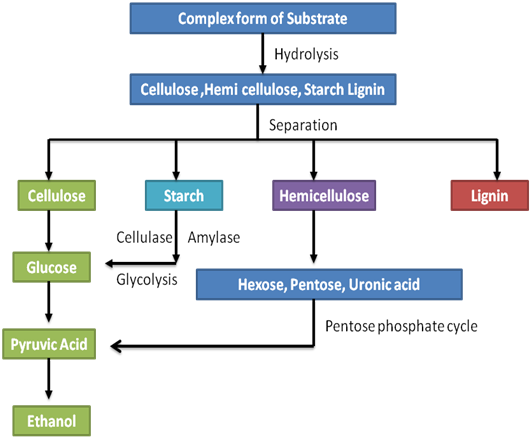Bioethanol Production
Commercial bioethanol is currently produced from starch/ sugar-based crops including sugar cane, sugar beet, sweet sorghum, corn, wheat, barley, potato, yarn, and cassava. One commercially-practiced technology is to produce ethanol by fermenting plant biomass derived simple sugars (i.e., glucose, fructose, and other monosaccharides). The problem lies with the use of this biomass for ethanol production is it’s pretreatments to obtain simple sugars that are bind with hemicellulose and lignin. Research has been intensively conducted to develop effective pretreatment methods for obtaining simple sugars from lignocellulosic materials such as sweet sorghum, Cassava, elephant grass, suger beets etc.
Process involved in bioethanol production
Pretreatment process
Pretreatment is used to remove the lignin and there are several pretreatment methods:- Concentrated Acid Hydrolysis Process , Dilute Acid Hydrolysis , Enzymatic Hydrolysis, Wet Milling Processes, Dry Milling Process.
Saccharification Process
It’s a enzymatic hydrolysis processes where cellulase enzyme degrade the cellulose to sugar. Cellulase producing common fungie are Aspergillus niger , Trichoderma reseesi used for cellulose degradation and further this sugar go for fermentation.
Sugar fermentation Process
The hydrolysis process breaks down the cellulostic part of the biomass into sugar solutions that can then be fermented into ethanol. Yeast is added to the solution, which is then heated. The yeast contains an enzyme called invertase, which acts as a catalyst and helps to convert the sucrose sugars into glucose and fructose (both C6H12O6).
Fractional distillation process
The ethanol, which is produced from the fermentation process, still contains a significant quantity of water, which must be removed. This is achieved by using the fractional distillation process. The distillation process works by boiling the water and ethanol mixture. Since ethanol has a lower boiling point (78.3C) compared to that of water (100C), the ethanol turns into the vapour state before the water and can be condensed and separated.

Fig. Process of bioethanol production from lignocellulosic biomass.